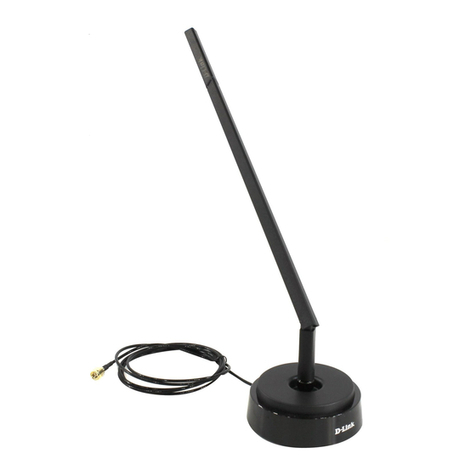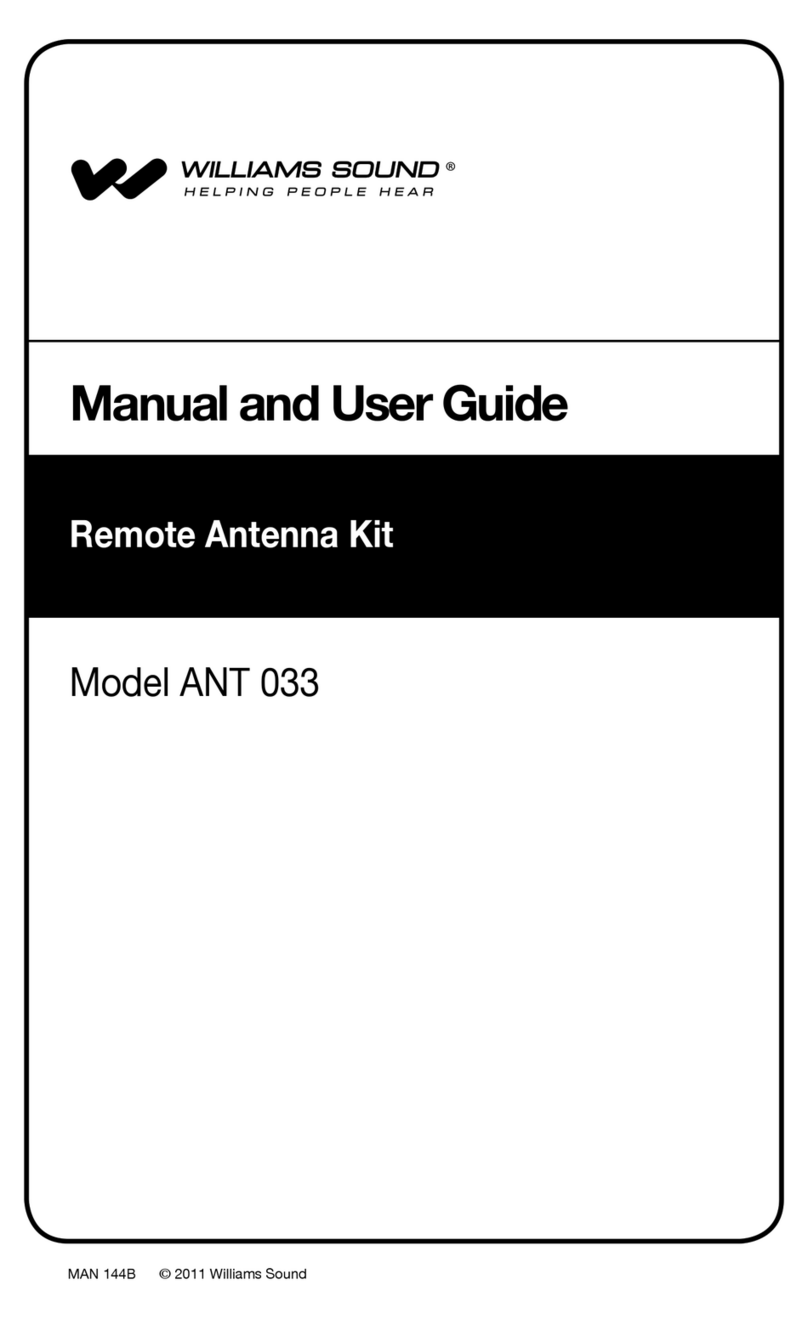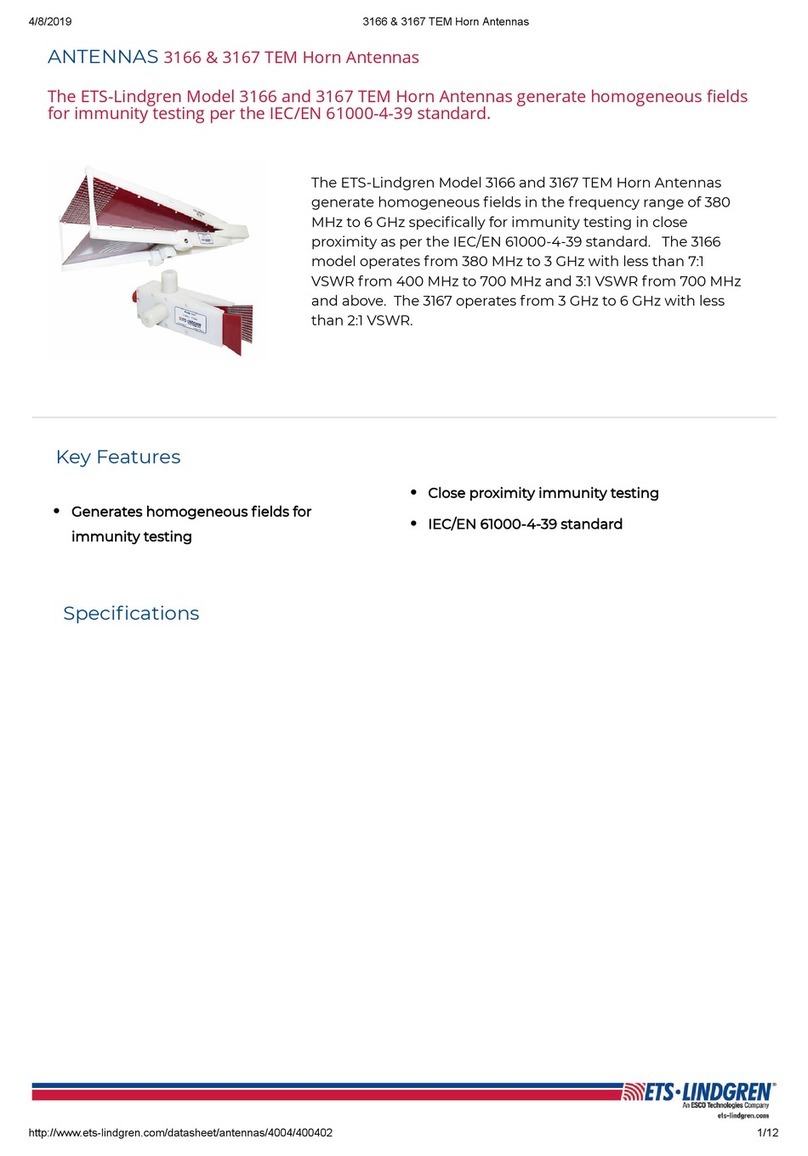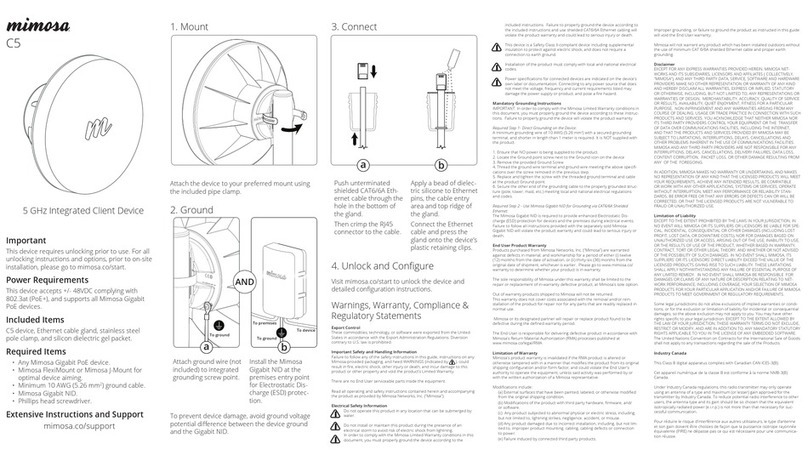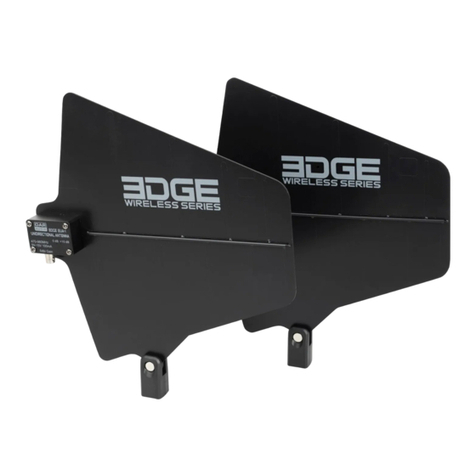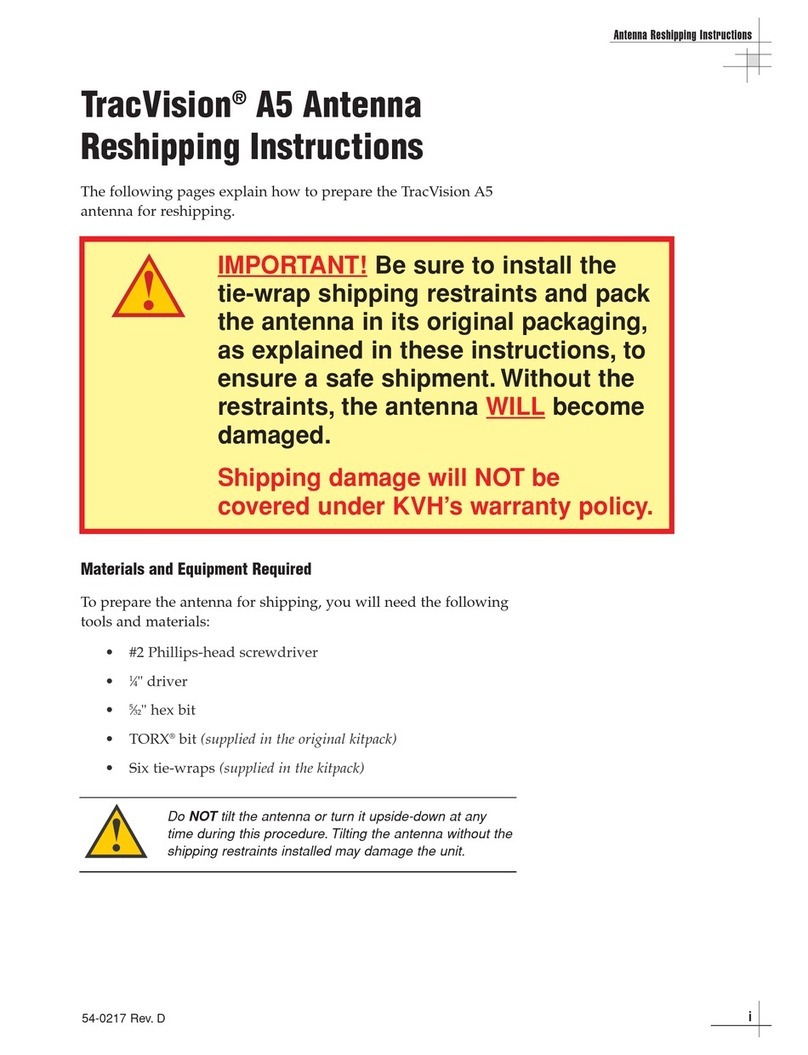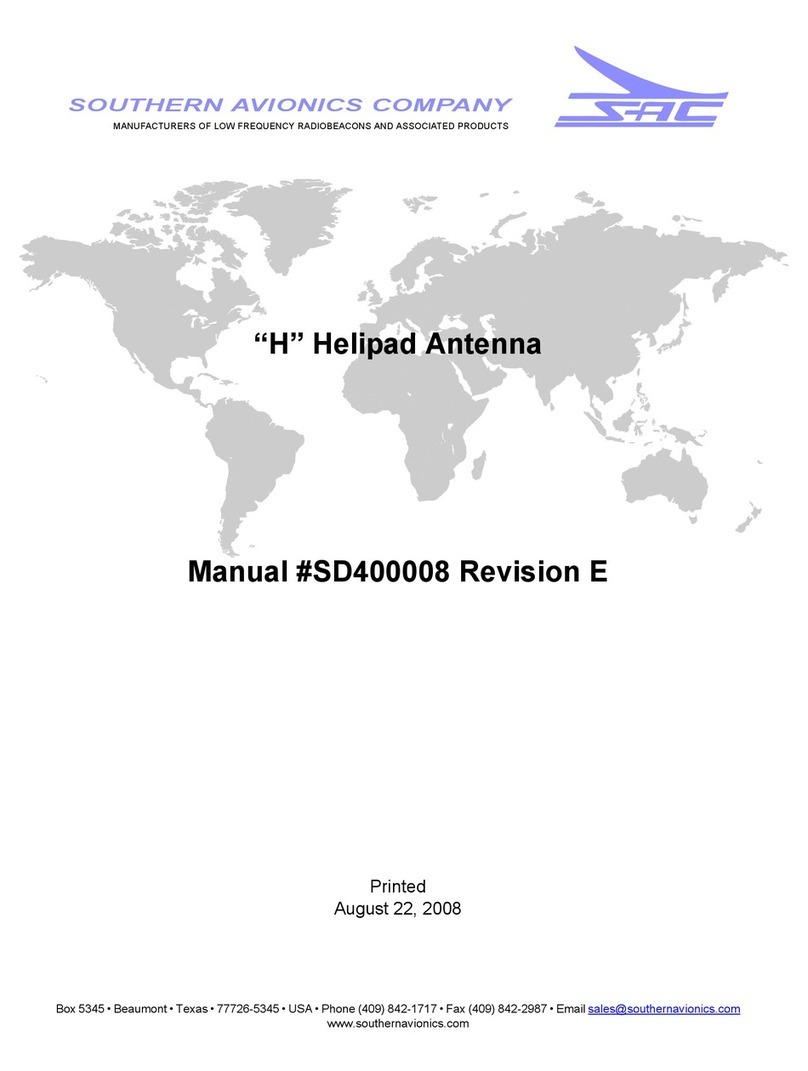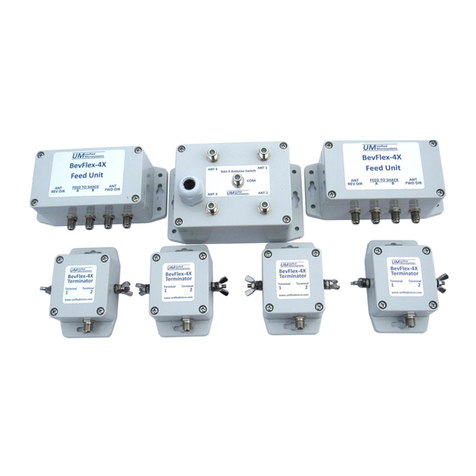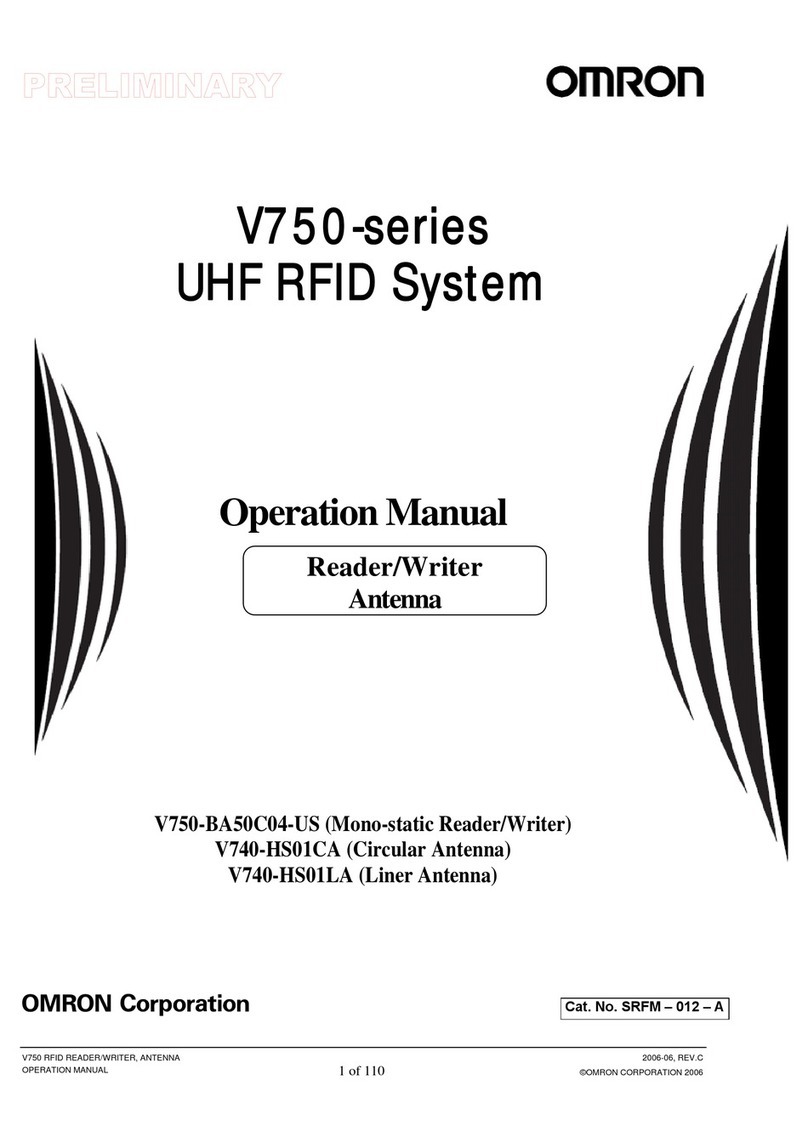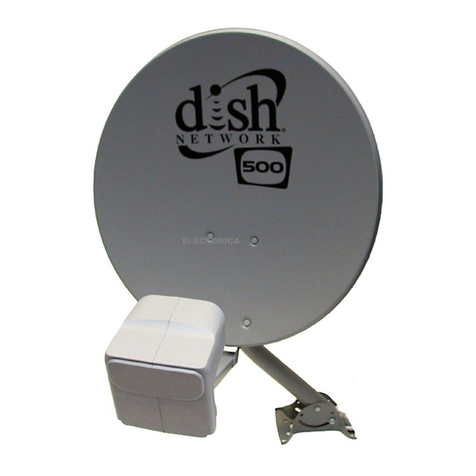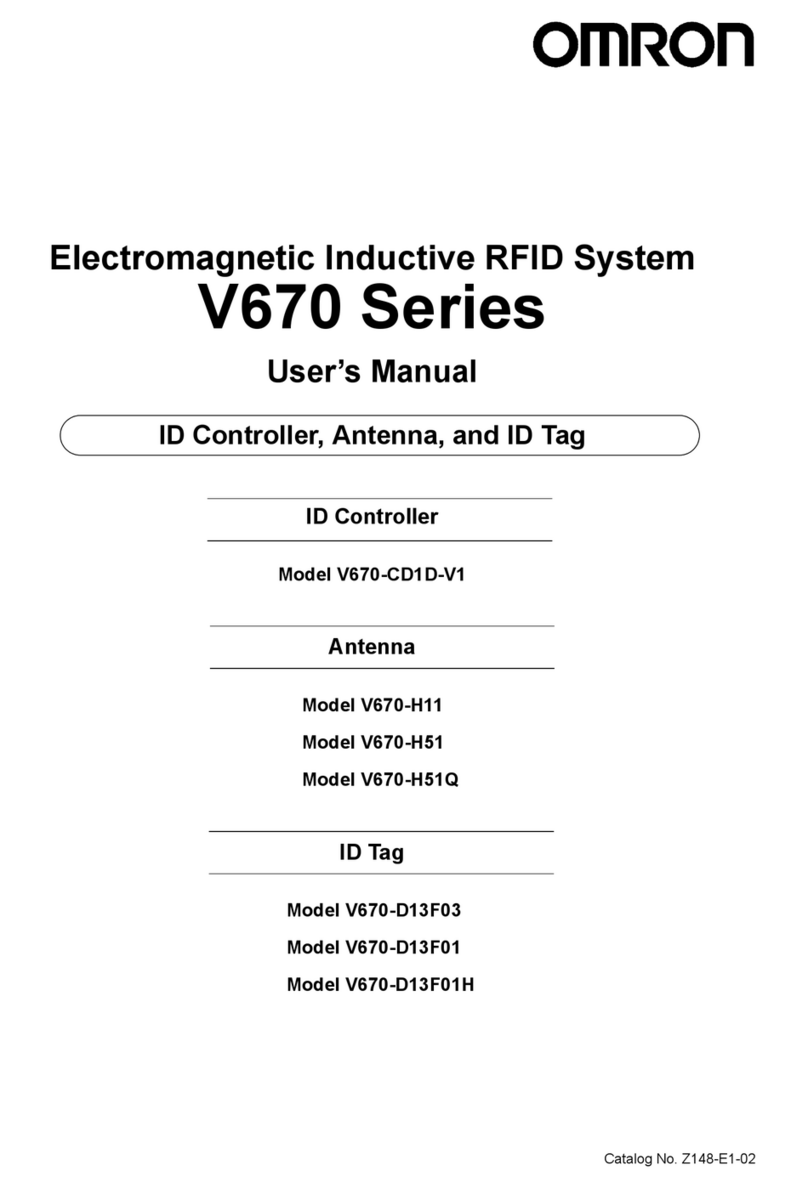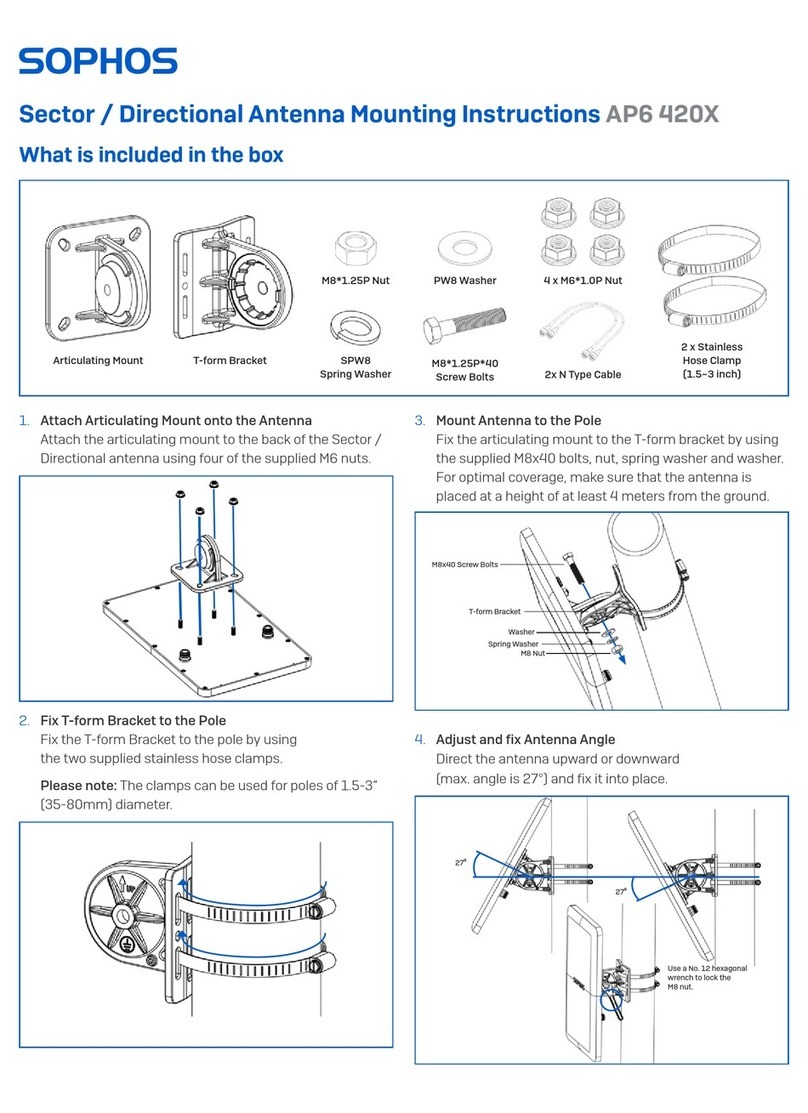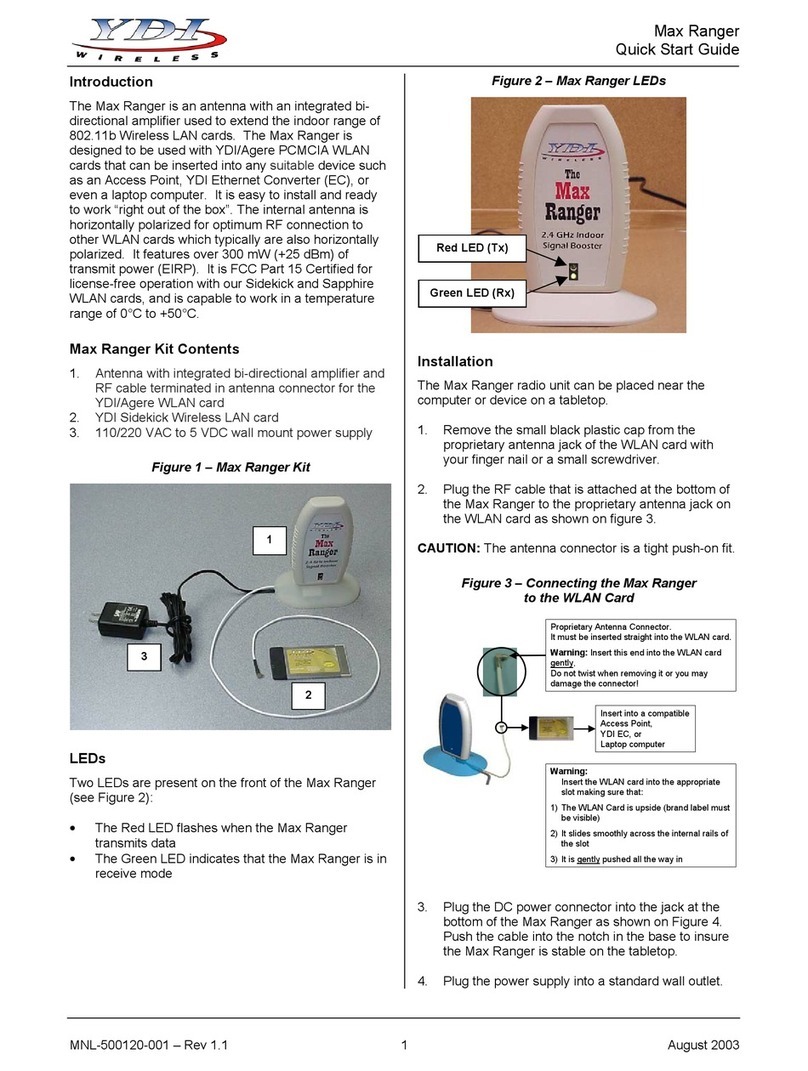Shively Labs 6814 User manual

Circularly Polarized FM
Broadcast Antenna
Model 6814
Instruction Manual
Installation, Operation, &
Maintenance

2
Congratulations! Thank you for purchasing one of the finest FM broadcast antennas on the
market today. The Shively Labs Model 6814 is widely recognized as the top-
of-the-line in its class for its superior performance and durability.
Your purchase is backed by the best technical support in the industry. Shively
is a leading manufacturer in the broadcast industry, providing an extensive
range of antennas, transmission line and components. Our technical staff has
a wealth of experience in the broadcast industry and is standing by to serve
you in any way.
This manual is intended to give you a good basic understanding of your
antenna: its proper and safe installation, startup, and operation, and trouble-
shooting and maintenance information to keep it working satisfactorily for
years to come.
Please have everyone involved with the antenna read this
manual carefully, and keep it handy for future reference.
Meanwhile, please feel free to contact your sales representative at Shively
Labs at any time if you need information or help. Call or write:
Publication No. im-6814 (150601)

IMPORTANT
Please read this manual in its entirety before beginning
installation of your antenna!
Failure to follow the installation and operation
instructions in this manual could lead to failure of your
equipment and might even void your warranty!


i
Table of Contents
Chapter 1 Precautions and Preparation.............................................1
Precautions...........................................................................................1
Receiving..............................................................................................1
Unpacking ............................................................................................1
Checking the system .............................................................................2
Chapter 2 Antenna Installation..........................................................3
Precautions...........................................................................................3
Installing the radiators...........................................................................3
Figure 1 Baymount detail................................................................3
Figure 2 Radiator installation, exploded view.................................... 4
Figure 3 Flange bolt tightening sequence .........................................5
Table 1 Torque Specifications, Flange Bolts......................................5
Installation of radomes (if applicable).....................................................5
Figure 4 Radome installation........................................................... 6
Figure 5 Ground strap installation.................................................... 7
Installing the feedline mounts................................................................7
Figure 6 Common feedline mount configurations .............................. 8
Installing the feedline sections...............................................................9
Figure 7 Feedline flange detail......................................................... 9
Installing the transformer ....................................................................10
Figure 8 Transformer installation, top view..................................... 10
Chapter 3 De-Icer Installation (if applicable)..................................11
Precautions......................................................................................... 11
De-icer system description...................................................................11
Dual-setting thermostat................................................................. 11
Electric power ...............................................................................11
Figure 9 De-Icer electrical schematic diagram................................. 12
Table 2 De-Icer specifications ....................................................... 13
De-icer installation .............................................................................. 13
Installing the de-icer harness ......................................................... 13
Figure 10 Bay junction box installation........................................... 14
Installing the thermostat (if applicable)...........................................14
Table 3 Thermostat readings......................................................... 15
Chapter 4 Startup and Operation.....................................................17
Precautions......................................................................................... 17
Pressurization ..................................................................................... 17
Test for leaks................................................................................ 17
Purge the system ..........................................................................17
Figure 11 Pressurized gas schematic.............................................. 18
Table 4 Volume of coax per 1000 feet of length.............................. 19
Leave the system pressurized.........................................................19

ii
Table of Contents
Impedance trimming...........................................................................20
Figure 12 Impedance-matching transformer................................... 20
Table 5 Factory control rod settings............................................... 20
System sweep (recommended) ............................................................ 21
Checkout............................................................................................21
Antenna operation............................................................................... 22
De-icer system operation.....................................................................22
Shively Labs de-icer control system ................................................ 22
Chapter 5 Maintenance ....................................................................23
Precautions......................................................................................... 23
Maintenance log..................................................................................23
Physical inspection .............................................................................. 23
De-icer check...................................................................................... 24
Paint..................................................................................................24
Radiator removal for repair.................................................................. 24
Return policy ...................................................................................... 24
Troubleshooting.................................................................................. 24
Internal arcing ..............................................................................24
Broad spectrum RF noise ............................................................... 24
High VSWR at startup or during operation....................................... 25
Erratic VSWR during impedance trimming ....................................... 25
Change in coverage....................................................................... 26
Pressure loss or excessive gas usage .............................................. 26
Sample maintenance log......................................................................27

1
Precautions and Preparation
1 Precautions and Preparation
Precautions WARNING
Don't expose personnel to the medical hazards of intense radio fre-
quency (RF) radiation. Whenever working on the tower in the area of
the antenna, turn off all transmitters and lock them out so that they can-
not be turned on accidentally.
For reference on RF safety, see CFR 29, Section 1910.97, the OSHA standard
for exposure to non-ionizing radiation.
Receiving As soon as you receive your antenna,
BEFORE
signing for the shipment:
a. Check to be sure all the material has arrived.
NOTE
The box number and the total number of boxes are marked on each box;
for example, “Box 2 of 5” means “box number 2 of a total of five boxes.”
b. Check for evident damage to any of the boxes.
c. If any boxes are missing, or if any are obviously damaged, describe the
problem in a WRITTEN note on the shipping papers BEFORE signing them.
Then call Shively right away, and we’ll do everything we can to correct the
situation.
Important!
Never store the antenna system outdoors, boxed or otherwise. Take
pains to keep the antenna components dry. You will need to purge mois-
ture from the interior of the antenna components before applying trans-
mitter power, and purging will be much more time-consuming if the
components get wet.
Unpacking a. Find Box 1; it is marked “Open This Box First.” It contains the transformer
and two copies of the installation drawing. The parts list on one sheet of the
installation drawing shows what box each item is in.
b. Then open the boxes and examine for shipping damages. File any necessary
claims with the carrier immediately.
c. If all the boxes are present and in good condition but material seems to be
missing, please contact Shively Labs immediately, using the telephone or Fax
number on the inside cover of this manual. For the best service, have our
shop order number (S/O) handy; it's in the block at the bottom right corner
of the installation drawing.
d. Along with your antenna you will get a spare parts kit. Place this in a safe
place until it is needed.
CAUTION
All contact surfaces and openings to the interior of the components are
protected from contamination and from physical damage by caps and
plastic bags. Do not remove this protection until ready to connect the
components.

Precautions and Preparation
2
Checking the system Remember!
It is YOUR responsibility to ensure that your installation meets all appli-
cable codes and the centerline-of-radiation requirements of your FCC
construction permit.
Shively has planned the installation of the antenna based upon information
provided by you. If this information contained errors, the parts and mounting
hardware will have been designed incorrectly and will cause expensive delays
in installation.
Therefore, we recommend that you recheck the installation
parameters during this planning stage.
Check all the parts to be sure that they will fit the tower and each other. Study
the installation drawings carefully to confirm that the information used in
designing the antenna and mounts was, in fact, accurate.
Have a reliable tower person, familiar with antennas and coaxial line, inspect
the tower and review the installation drawings before the full rigging crew
arrives.
If design problems are found, contact Shively Labs immediately. Pay particu-
lar attention to:
• Frequency of the antenna.
• Fit of the mounts to the tower members.
• Freedom from interference by gussets, leg flanges, guys and their
attachment points, tower face members, obstruction lights, and
other components.
• Compatibility of transmission line and antenna input terminals.
• Location of the transmission line run relative to the antenna input
terminal.
• Use of non-metallic guy sections on the tower in the region to be
occupied by the FM antenna. Ensure that there are no metal guys
within ten feet (three meters) of any radiator.
• Availability of proper electrical service for de-icers, if applicable.
• The adequacy of the tower structure and guys to carry the wind-
load placed upon them by the antenna, particularly if radomes are
used.
You gave Shively this information at the time of purchase, but a last check at
this time can catch an error, which will be easier to correct before installation
begins.

3
Antenna Installation
2 Antenna Installation
Precautions WARNING
Don't expose personnel to the medical hazards of intense radio fre-
quency (RF) radiation. Whenever working on the tower in the area of
the antenna, turn off all transmitters and lock them out so that they can-
not be turned on accidentally.
Installing the radiators It will be easiest to mount the radiators onto the feedline sections before the
feedlines are mounted on the tower.
a. Pair up the feedline sections and the radiator assemblies, using the bay
number stenciled on each piece.
CAUTION
To prevent damaging the copper feedline, use clamps rather than
U-bolts, and don’t overtighten.
b. Lay a feedline section horizontally, supported off the ground, with its
baymount flange pointing upward. Secure the feedline section at the brass
end, using clamps, to prevent its turning with the weight of the radiator.
Figure 1. Baymount detail
CAUTION
All contact surfaces and openings to the interior of the components are
protected from contamination and from physical damage by protective
covers and plastic bags. Do not remove this protection until ready to
connect the components.
c. Remove the plastic bag and protective cover (see Figure 1) from the
baymount flange on the feedline.
d. Feedline flange hardware and baymount flange hardware are shipped
separately in plastic bags. Each bag contains the hardware for one flange.
O-rings are also shipped in a separate bag.

Antenna Installation
4
CAUTION
All O-rings are made of silicone. Do not lubricate them with silicone
grease, as this will soften the O-ring. Use only a light lubricating coat of
O-Lube (provided) or petroleum jelly; too much may hamper electrical
contact and contaminate the interior of the system.
Be sure the O-ring is properly seated in its groove and not pinched
between the flange contact surfaces.
e. Remove the O-ring and coat it lightly with O-Lube (supplied with the
antenna), then reinstall it in the O-ring groove in the flange.
f. Before installing the bay radiator, make sure an inner conductor connector
is in place in the inner conductor of the baymount flange.
CAUTION
Assemble components in accordance with the installation drawing. If you
don’t, the antenna may not perform as expected.
g. Remove the matching radiator assembly from its protective plastic bag.
CAUTION
Be sure the radiator’s inner conductor fits cleanly over the baymount’s
inner conductor connector. If any of the fingers of the connector are
forced outside the radiator’s inner conductor (a "split bullet"), this will
cause arcing and damage to the antenna.
h. Align the radiator with the baymount flange as shown in Figure 2, with the
top pointing toward the nearby feedline flange. Carefully place the radiator
into position over the flange studs and inner conductor connector.
Figure 2. Radiator installation,
exploded view
i. First snug the flange bolts in the sequence shown in Figure 3, then tighten
them in accordance with Table 1.
Important
Be very careful not to dis-
turb or damage the feed
strap when handling the
radiator.

5
Antenna Installation
Figure 3. Flange bolt tightening
sequence
j. Clamp the mounting saddle to the feedline, using a clamp.
CAUTION
Feedstrap orientation is critical to performance. In general, the feed-
straps in a full-wave-spaced antenna will all be oriented the same, while
those in a half-wave-spaced antenna will alternate.
Install each radiator
in accordance with its stenciled bay numbers and its "up-arrow" sticker.
k. Determine what, if any, icing protection your antenna has.
• If you antenna has de-icers, go to Chapter 3.
• If your antenna has radomes, continue.
Installation of radomes
(if applicable) If your system includes radomes, you can most easily install them on the
ground at this time. See Figure 4 on page 6.
a. Each radome is shipped partially assembled on its own pallet. Disassemble
the radome halves and the radome mount.
b. Identify the top (wide mating flange) and bottom (narrow mating flange and
drain holes) radome halves.
NOTE
The feedline comes with a 20-inch-long extension in place (see Figure
2). This extension, in effect, moves the feedline joints outside the
radome, and thus allows you to mount the radome on the ground. You
should treat the feedline with its extension as a single unit.
c. Remove the closure plate bolts where the mount will slip under the closure
plate. Loosen the other closure plate bolts and leave the closure plates in
place on the radome.
d. Place four clamps loosely around the feedline, two above and two below the
baymount flange. Mounting the saddle is easier if the clamps are in place
first.
e. Locate the mount on the feedline as shown, centered exactly opposite the
baymount flange (use a ruler or a level to center it). The uppermost part of
the mount should be one inch from the flange of the feedline extension.
Table 1. Torque Specifications, Flange Bolts
Transmission Line
Size Bolt Size Torque
1-5/8" 5/16-18 12 ft-lb 16 N-m
2-1/8" 3/8-16 21 ft-lb 28 N-m
3-1/8" 3/8-16 21 ft-lb 28 N-m
4-1/16" 3/8-16 21 ft-lb 28 N-m

Antenna Installation
6
f. Using the four clamps, clamp the mount saddle to the feedline.
g. Place the top radome half over the radiator and into the mount, slipping the
end of the mount under the closure plate.
h. Place the bottom radome half over the radiator and feedline and into the top
radome half, inserting its mount into its closure plate.
i. Bolt the radome halves loosely to the mount with the mount bolts
(3/8" with lock washers and flat washers).
Figure 4. Radome installation
j. Fasten the two radome halves together with the 1/4" flange hardware,
starting at the feedline side and working around both sides to the outer edge.
Tighten the flange hardware.
NOTE
You may have to squeeze the radome flanges together slightly with a
clamp to start the nuts. Get all these nuts and bolts in place, then
tighten them.

7
Antenna Installation
k. Twist and clamp the loose ends of the ground straps to the feedline, as
shown in Figure 5. This will prevent arcing between the mount and the
feedline.
Figure 5. Ground strap
installation
l. Tighten the closure plate bolts and the mount bolts, securing the bolted ends
of the ground straps as well.
Important
Be very careful to seal the joint completely. If water enters the radome,
the antenna will not perform as expected, and may cause damage to
your entire system.
m. Seal the closure plates and the joint where the radome encircles the
baymount with the silicone sealant supplied with the antenna.
Installing the feedline
mounts Feedline mounts vary from installation to installation, to accomodate various
tower and mounting pole requirements. Figure 6 shows several common con-
figurations. Your feedline mounts may be one of the common designs shown;
if they are not, they will be shown in detail on your installation drawing.
Before you begin installation, study the mounts, the mounting tower leg(s) or
pole, and your installation drawing carefully, establishing which mount(s) will
be used for each component.
a. On the tower, starting at the top, use a steel measuring tape to find the
location of each bay in accordance with the installation drawing. Mark the
mount locations.
b. Mark the specified location of any accessory mounts, such as for the
transformer or special coax input line sections, to make sure they will fit as
planned.
c. Watch carefully for any interferences by tower members or guy wires which
were not accounted for in the design.

Antenna Installation
8
Figure 6. Common feedline
mount configurations
Mounts may vary from bay to bay, especially on tapered towers or where
tower obstructions exist. See your installation drawing for your mount
configuration and special requirements, if any.
CAUTION
If you don't get good electrical contact between the mounts and the
tower, the antenna may not perform as designed, and may produce
stray signals that will interfere with other services on the tower.

9
Antenna Installation
d.
Where the mounts will be in contact with the tower or pole, scrape the tower
paint away to ensure good electrical contact.
e. Secure the feedline mounts to the tower leg(s) or mounting pole using
U-bolts.
f. When all mounts are in place, sight along them vertically and align them
before finally tightening the hardware.
g. Touch up any exposed metal on the tower or pole.
If any problems appear during this process, please call Shively Labs and dis-
cuss them with the installation designer.
Installing the feedline
sections CAUTION
Feedline flanges are match-marked. Assemble components in accor-
dance with their match-markings (see Figure 7) and the installation
drawing. If you don’t, the antenna may not perform as expected.
Figure 7. Feedline flange detail
CAUTION
The feedline inner conductors include "bullet guides" (see Figure 7) to
help prevent split bullets. Be sure the bullet guides are in place before
assembly.
a. Install the feedline sections, transformer, and other components carefully, in
accordance with your installation drawing and the illustrations in this
chapter.
b. Secure the feedline to the mount saddles using the clamps provided
(generally, two clamps on a 6"-long saddle and 4 clamps on a 12"-long
saddle). To align the antenna to the proper azimuth, match the stenciled line
on the feedline with the weld dot on the top edge of the mount saddle.
CAUTION
To prevent damage to feedline, be sure the feedline mount saddles are
located against the brass portion of the feedline, and position the clamp
screw housings over the saddles, not against the feedline.
Important!
To avoid damage to the
antenna, always lift, posi-
tion, and attach each sec-
tion individually. Never try
to transport connected
feedline sections! This rule
is often violated and is fre-
quently the cause of
expensive damage to feed-
line.

Antenna Installation
10
c. As each feedline section is lifted into place, remove the plastic bags and
protective covers from the flanges and install an O-ring, lubricating it with a
light coat of petroleum jelly (provided with the antenna) Tighten the flanges
in accordance with Figure 3 and Table 1 on page 5.
d. Secure each feedline section to its mount before installing the next section.
Installing the
transformer One of the unique features of Shively Labs antenna systems is the adjustable
impedance-matching transformer provided with the antenna. It allows the
installer to compensate for changes in the input impedance caused by the
installation (tower, conduit, ladder, etc.).
Figure 8. Transformer
installation, top view
NOTE
The transformer may be oriented in whichever direction you wish (see
Figure 8). Make it easy for yourself to reach for adjustment at startup.
Install the transformer between your transmission line and the feedline. The
male end (with the inner conductor connector in place) always goes at the
top. Transformer mounts are generally similar to feedline mounts and should
be installed in the same manner.

11
De-Icer Installation (if applicable)
3 De-Icer Installation (if applicable)
Precautions WARNING
Don't expose personnel to the medical hazards of intense radio fre-
quency (RF) radiation. Whenever working on the tower in the area of
the antenna, turn off all transmitters and lock them out so that they can-
not be turned on accidentally.
CAUTION
All parts of the de-icer system within approximately 20 feet (6 meters) of
any radiator must be shielded from RF energy, and the entire outdoor
portion of the system must be made waterproof.
CAUTION
An improperly installed de-icer can overheat and damage your antenna.
De-icer system
description The de-icer system consists of the heating elements in the bays, their branch
cables, and the main harness. The main harness consists of a bay junction box
for each antenna bay, interbay cables, and a "pigtail" of wires about 10 feet (3
meters) long which you will connect to the tower junction box you are to pro-
vide. The following will help in installation:
• System electrical schematic: Figure 9 on page 12.
• Electrical specifications: Table 2 on page 13.
• Bay junction box: Figure 10 on page 14.
• Thermostat readings: Table 3 on page 15.
Your system may also include specially-ordered items, such as a ground-
mounted main control box, a power cable extending up the tower, or a tower-
mounted dual-setting thermostat.
Dual-setting thermostat CAUTION
Remember that conditions may be favorable for icing on the tower, even
if they are not on the ground.
Shively Labs de-icers are designed to prevent ice from forming on antenna
elements and are not designed to melt ice that has already formed. For this
reason, Shively Labs recommends that the system be installed with a tower-
mounted dual-setting thermostat assembly (Shively Labs Model 55522-G502)
and de-icer control box (Shively Labs Model 94068) that ensure the de-icers
are operated in the temperature range ice is most likely to form.
Electric power The de-icer system requires 220 VAC, 50 - 60 Hz., single-phase. Table 2 on
page 13 shows approximate heater leg resistances and current draw, respec-
tively, measured at the tower junction box (Figure 9 on page 12).
WARNING
Installation should be per-
formed only by personnel
experienced in RF sys-
tems, qualified in electri-
cal work, and familiar
with this equipment.

De-Icer Installation (if applicable)
12
Figure 9. De-Icer electrical
schematic diagram
NOTE
Customer-supplied items
are shown in broken lines.
NOTE
A liquid-tight conduit con-
nector (3/8" conduit size
by 1/2" hub size) for the
harness entry to the
tower junction box, is
packed loose with the de-
icer harness.
NOTE
Shively recommends the
use of shielded braided
polyethylene-covered wire
or rubber-sheathed flexi-
ble metal conduit or rigid
conduit and weather-tight
fittings at all junctions.

13
De-Icer Installation (if applicable)
De-icer installation
Installing the de-icer
harness a. Install the main de-icer harness with its bay junction boxes as shown in
Figure 9 on page 12 and Figure 10 on page 14. Connect the leads from each
bay’s de-icer pigtail to the main harness in that bay’s junction box as shown.
CAUTION
It is important to ground both the tower junction box and the control
box, as shown in the schematic diagrams.
b. Furnish a tower junction box as shown schematically in Figure 9 to connect
the antenna’s de-icer harness to the main power.
c. Using tie-wraps, secure the entire length of the de-icer harness to the RF
feedline at about 24" (60 cm) intervals. Run the ten-foot de-icer pigtail along
a feedline mount to the tower junction box and secure it to the mount and
the tower.
Table 2. De-Icer specifications
High-Band
(98.0-108.0 MHz Low-Band
(88.0-97.9 MHz)
Heater Leg
Resistance,
Heater Leg
(T1 or T2)
Current Draw,
amps
Heater Leg
Resistance,
Heater Leg
(T1 or T2)
Current Draw,
amps
1-Bay, single circuit 55 2.0 46 2.4
2-Bay 27 4.0 23 4.8
3-Bay 18 6.0 15 7.2
4-Bay 14 8.0 11 9.7
5-Bay 11 10.0 912.1
6-Bay 912.0 814.5
7-Bay 814.0 716.9
8-Bay 716.0 619.3
10-Bay, each of 2 circuits 12 10.0 812.1
12-Bay, each of 2 circuits 812.0 614.5
14-Bay, each of 2 circuits 814.0 816.9
16-Bay, each of 2 circuits 816.0 419.3

De-Icer Installation (if applicable)
14
Figure 10. Bay junction box
installation
Installing the thermostat
(if applicable) If you are using a thermostat, you may locate and mount it at your discretion.
We recommend mounting it as close as practical to the antenna.
CAUTION
When testing the thermostat, be sure to have one or both thermostat
leads disconnected before taking resistance readings. Otherwise, read-
ings may be affected by other components.
a. Before you connect the thermostat, measure the resistance across the
thermostat circuit and from it to ground to ensure that there are no short-
circuits. Thermostat readings should be as shown in Table 3 on page 15.
b. Mount the thermostat near the antenna and connect the thermostat leads to
points S1 and S2 in the control box as shown in the schematic diagram,
Figure 9 on page 12.
CAUTION
Shively Labs's de-icer
control box, Model 94068,
is designed for interior
installation only.
NOTES
Wire nuts, cover with
screws, and gaskets, and
tie-wraps are provided
with the de-icer cable har-
ness.
The antenna pigtail
grounds to the box via its
braided sheath.
The ground screw may be
in a different location from
that shown.
Table of contents
Other Shively Labs Antenna manuals
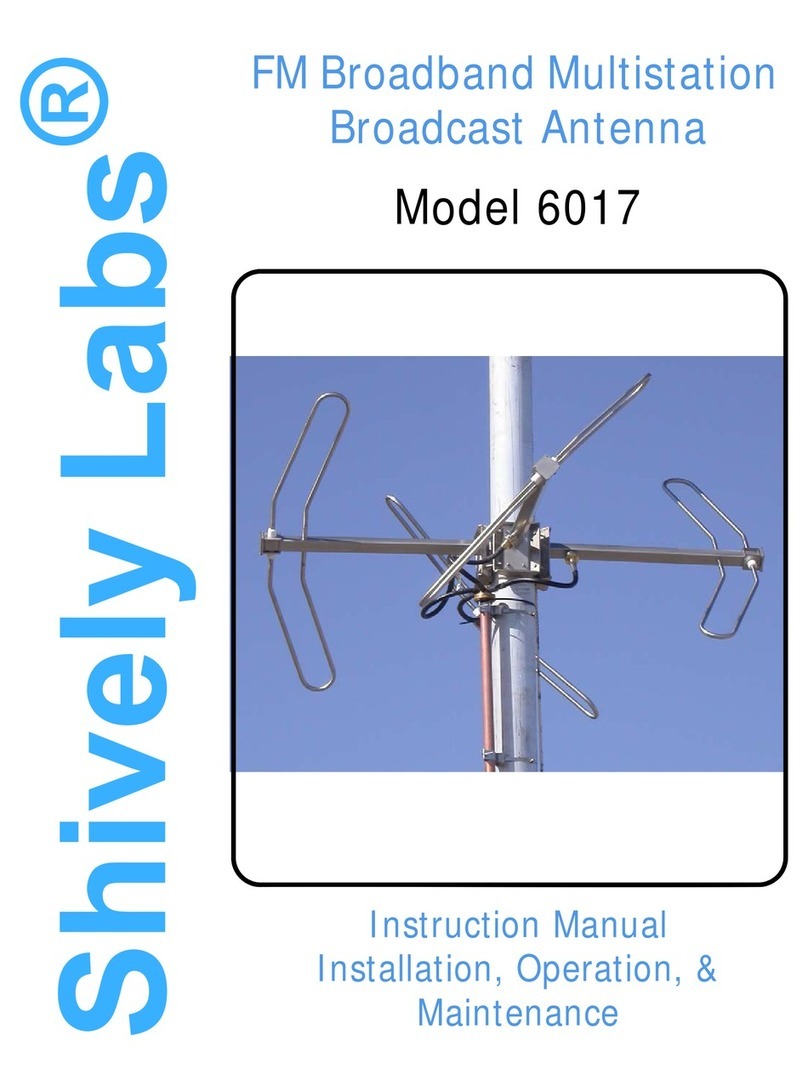
Shively Labs
Shively Labs 6017 User manual
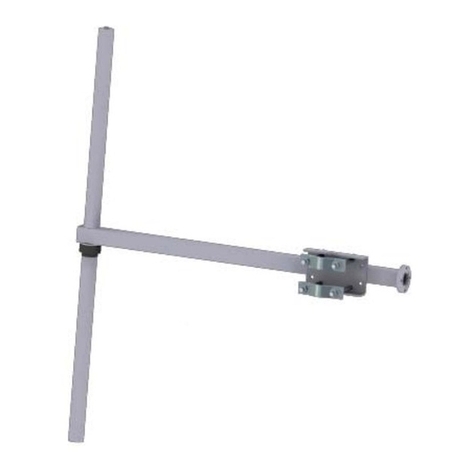
Shively Labs
Shively Labs 6020 Instruction Manual
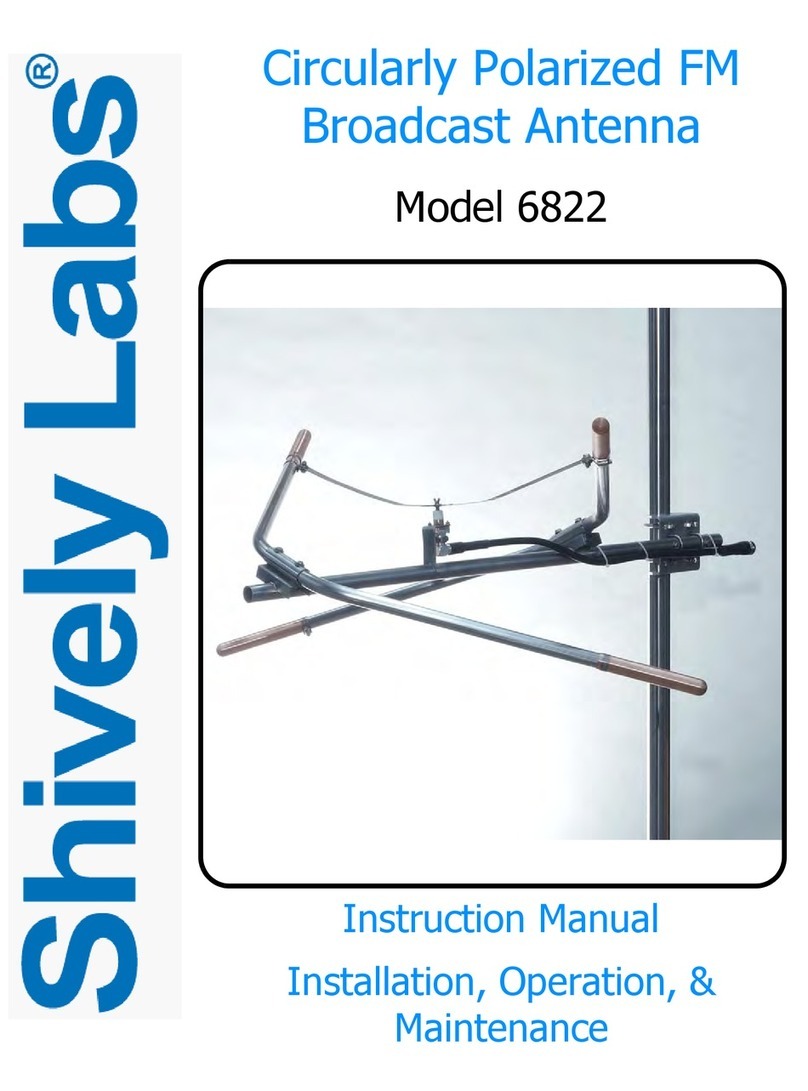
Shively Labs
Shively Labs 6822 Owner's manual

Shively Labs
Shively Labs Versa2une SLV User manual
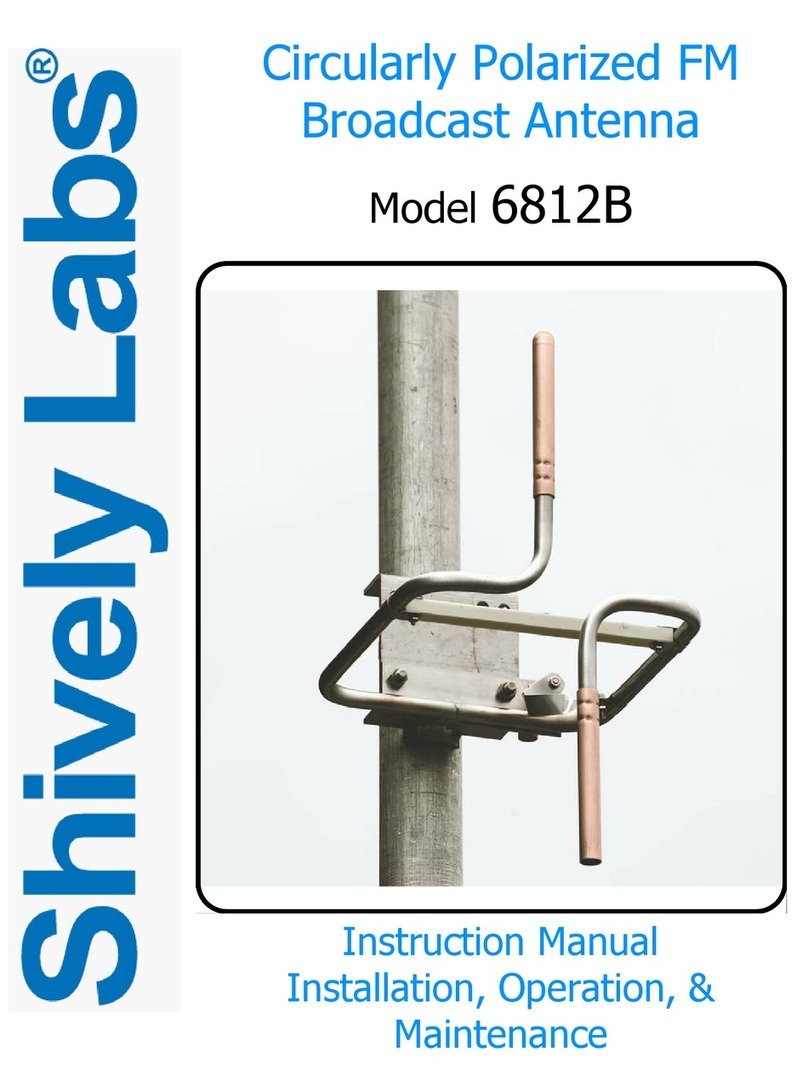
Shively Labs
Shively Labs 6812B Owner's manual
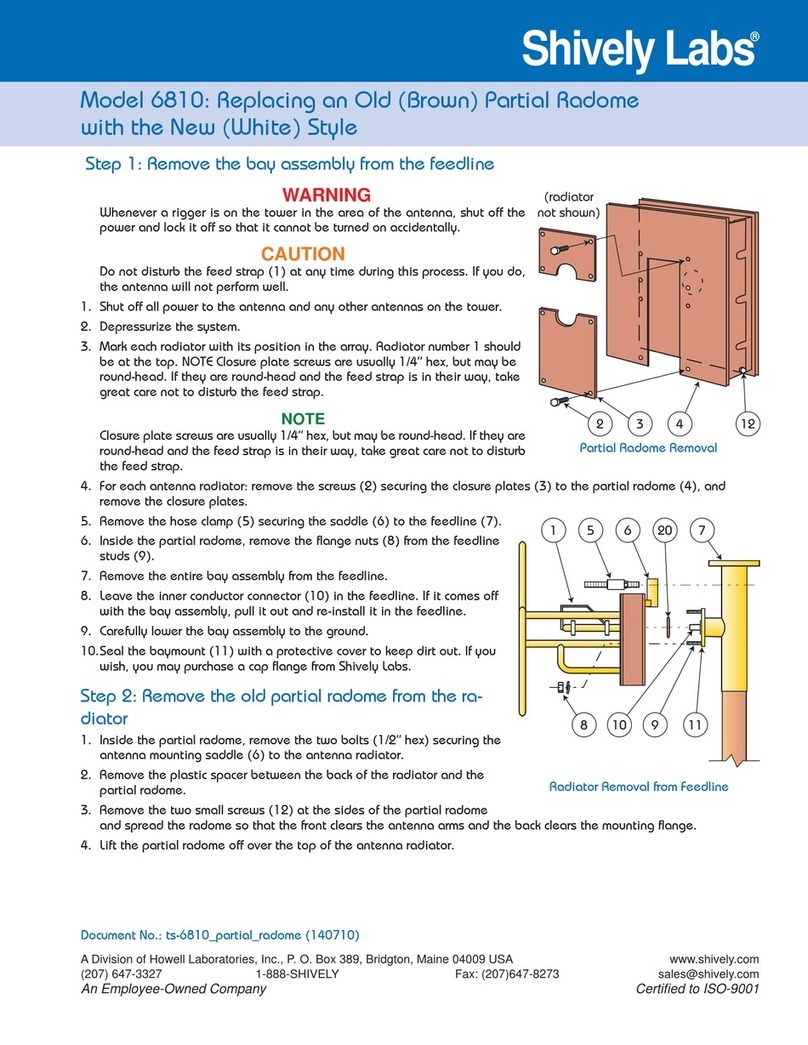
Shively Labs
Shively Labs 6810 Operating and safety instructions
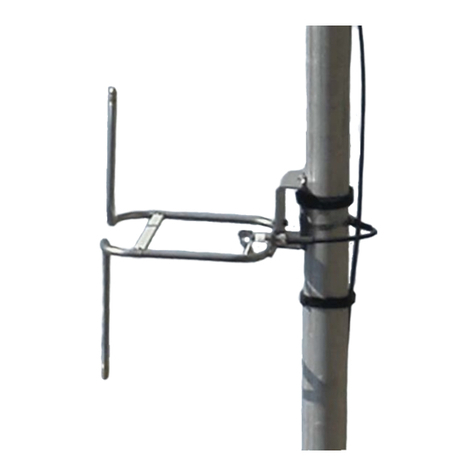
Shively Labs
Shively Labs 6812DIN Owner's manual
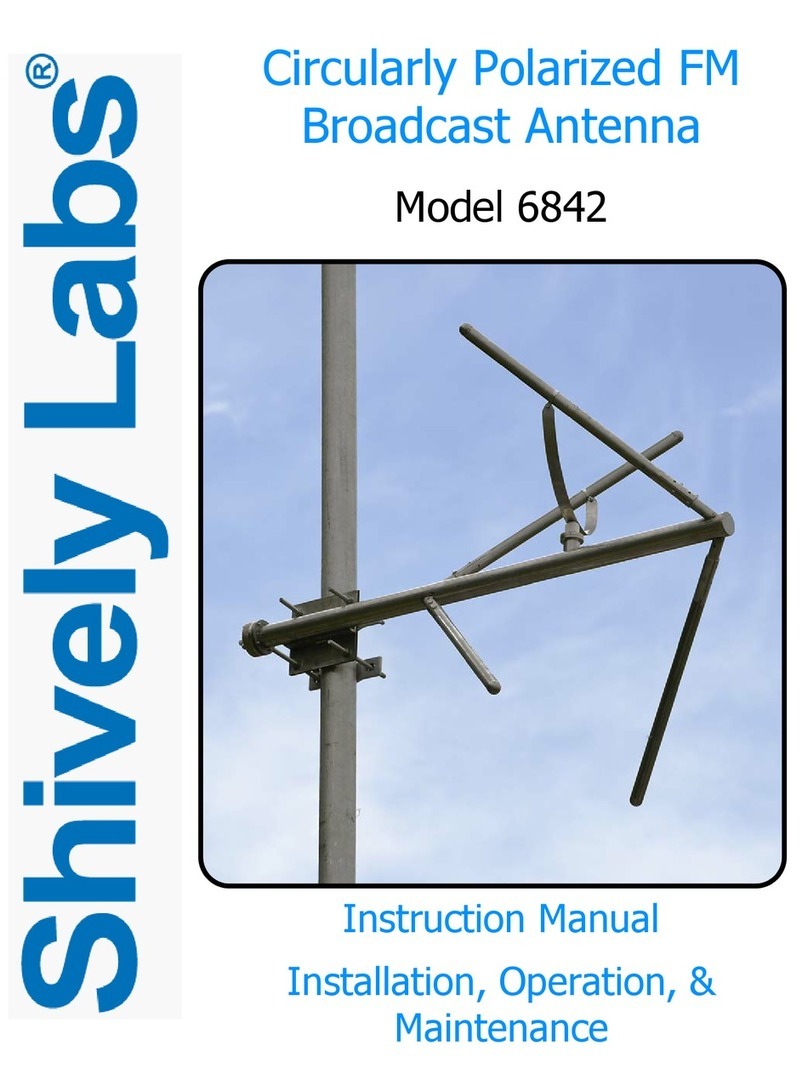
Shively Labs
Shively Labs 6842 Owner's manual

Shively Labs
Shively Labs 6810 Owner's manual
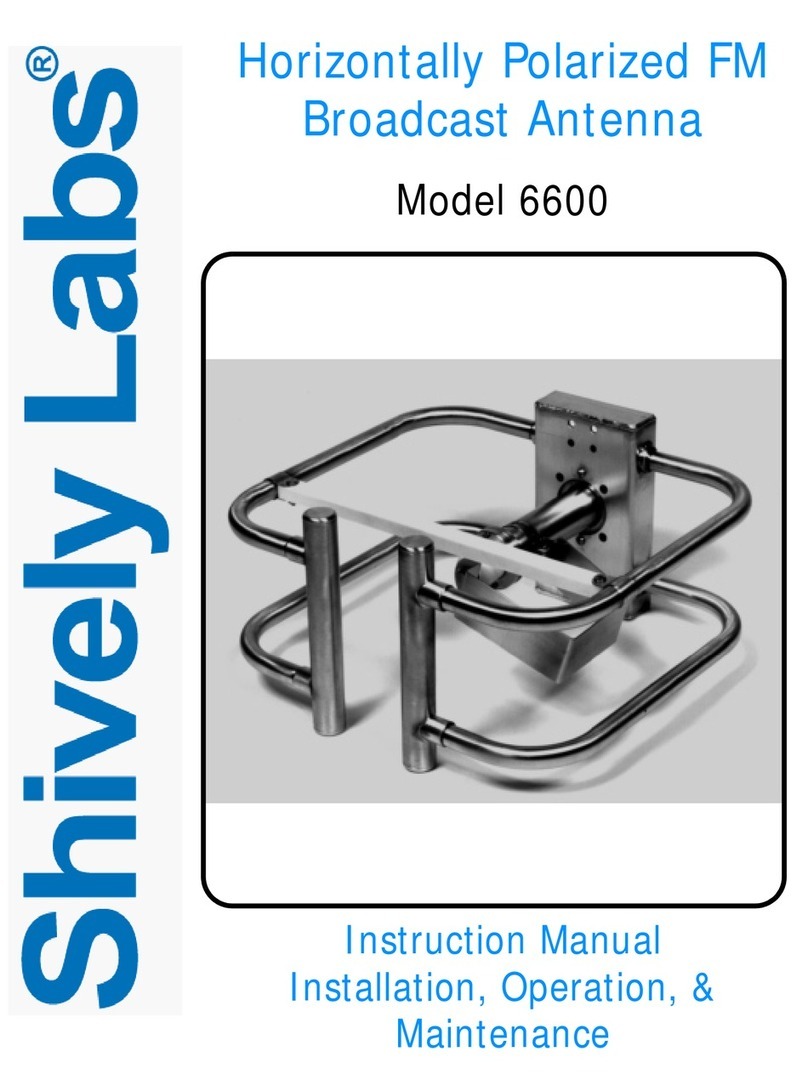
Shively Labs
Shively Labs 6600 User manual
